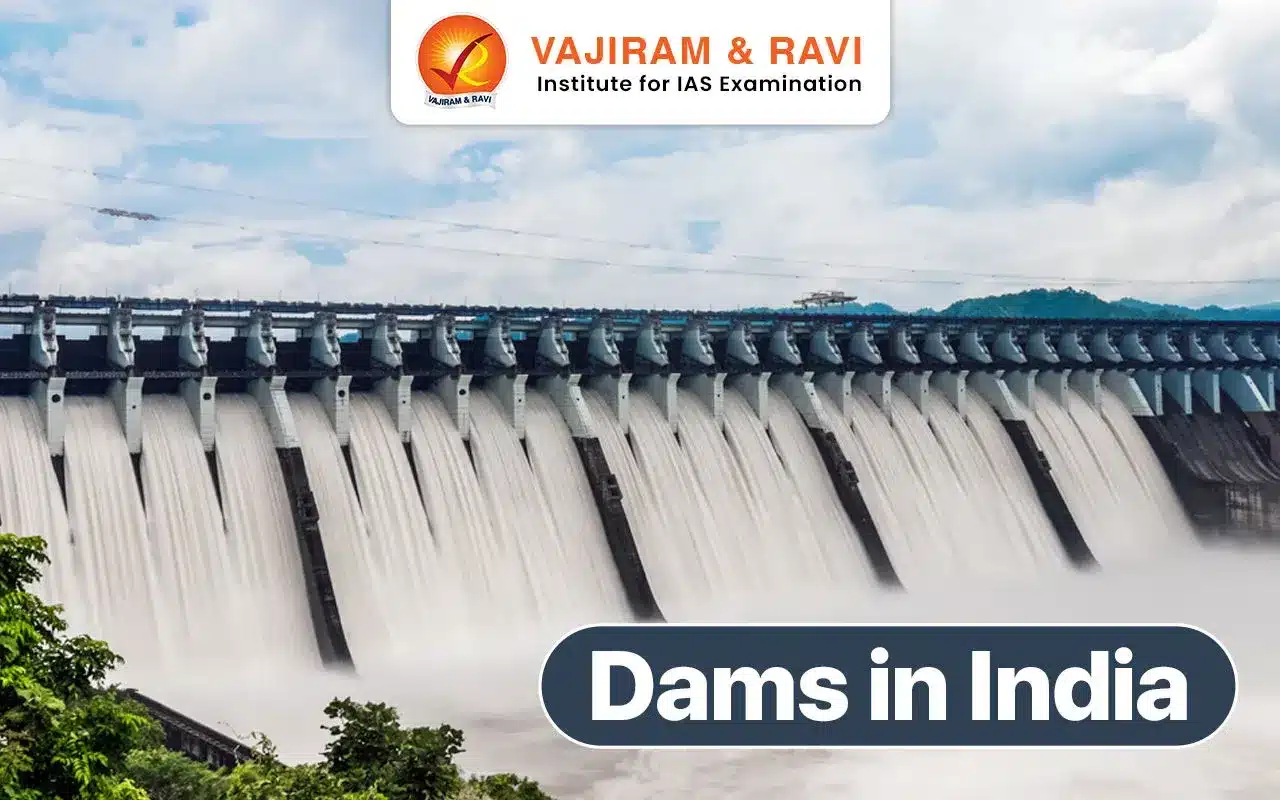Dams have been pivotal in India’s development, providing crucial irrigation for agriculture, clean hydroelectric power, and flood control. According tothe 7th Schedule of the Indian Constitution, water management falls under state jurisdiction. With 5,334 dams, including 447 significant ones, India’s water infrastructure is extensive.
However, a recent study by the United Nations University- Institute on Water, Environment and Health (UNU-INWEH),raises concerns about sediment accumulation, predicting a 26% loss in storage capacity for around 3,700 Indian dams by 2050.
Major Dams in India
Dams are massive structures used for reservoirs, water supply, and flood control. They are gravity-based, earth-fill dams, and arch dams, which are curved structures that transfer water force horizontally. They are critical components of a country’s water management infrastructure.
– The table below shows some of India’s major dams, their connected rivers, and the states where they are located:
| Dam | River | State |
| Tehri Dam | Bhagirathi | Uttrakhand
|
| Lakhwar Dam | Yamuna | |
| Ramganga Dam | Ramganga | |
| Koteshwar Dam | Bhagirathi | |
| Idukki Arch Dam | Periyar | Kerala |
| Cheruthoni Dam | Cheruthoni | |
| Kakki Dam | Kakki | |
| Idamalayar Dam | Idamalayar | |
| Mattupetty Dam | Palar | |
| Nagarjuna Sagar Dam | Krishna | Telangana |
| Srisailam Dam | Krishna | |
| Supa Dam | Kali Nadi | Karnataka |
| Krishnarajasagar Dam | Kaveri | |
| Tungabhadara Dam (Pampa Sagar) | Krishna | |
| Mullaperiyar Dam | Sholayar | Tamil Nadu |
| Mettur Dam | Cauvery | |
| Vaigai Dam | Vaigai | |
| Bhakra Dam | Satluj | Himachal Pradesh |
| Chamera Dam | Ravi | |
| Koyna Dam | Koyna | Maharashtra |
| Bhandardara Dam | Pravara | |
| Sardar Sarovar Gujarat Dam | Narmada | Gujarat |
| Dantiwada Dam | Banas | |
| Hirakud Dam | Mahanadi | Odisha |
| Mandira Dam | Sankh | |
| Rihand Dam | Rihand | Uttar Pradesh |
| Indira Sagar Dam | Narmada | Madhya Pradesh |
| Omkareshwar Dam | Narmada | |
| Gandhi Sagar Dam | Chambal | |
| Ranjit Sagar Dam | Ravi | Punjab |
| Bhakra Dam | Satluj | |
| Harike Barrage | Confluence of the Beas and Sutlej | |
| Baglihar Dam | Chenab | Jammu & Kasmir |
| Salal Dam | Chenab | |
| Chamera Dam | Ravi | Himachal Pradesh |
| Pong Dam | Beas | |
| Subansiri Dam | Subansiri | Arunachal Pradesh |
| Dibang Dam | Dibang | |
| Kameng Dam | Bichom and Tenga (Kameng tributaries) | |
| Hasdeo Bango Dam | Hasdeo | Chattisgarh |
| Dudawa Dam | Mahanadi | |
| Rana Pratap Sagar Dam | Chambal | Rajasthan |
| Bisalpur Dam | Banas |
Significance of Dams
Dams are critical to India’s water management and development efforts. They offer significant benefits, including:
- Renewable Energy Source: Many dams have turbines installed to generate electricity from the regulated water flow. These hydroelectric dams are a vital source of renewable energy for the country.
- For instance, In 2023, a hydropower capacity of about 46,865 MW (megawatt) accounted for roughly 11% of power generation capacity in India.
- Irrigation: Large dams have played a crucial role in improving irrigation facilities, increasing the area under cultivation, and boosting agricultural productivity, contributing to India’s self-sufficiency in food grain production.
- Flood control and water supply: During heavy rainfall, dams can prevent floods by controlling the release of water. Contrarily, they maintain a reliable water supply during dry conditions.
- Efficient land use: While large dams submerge land, they do so relatively sparingly compared to alternative small dams. They utilise land more efficiently and are capable of irrigating larger areas, providing multiple benefits including irrigation and power generation.
Impact of Dams
Despite the manifold benefits dams provide, they also present challenges. The following points elucidate the adverse impact of dams:
- Ecological impact: Dam construction causes habitat destruction, biodiversity loss, animal migration routes disruption, and wetlands devastation, impacting local populations and livelihoods, increasing flood risks, and affecting agriculture.
- Human impact: Displacement and urban migration lead to overcrowded cities and poor living conditions, and a disproportionate impact on vulnerable communities; for example projects like Sardar Sarovar Dam and Koel-Karo Dam.
- Financial impact: It can exceed initial estimates, leading to fiscal burdens for governments and borrowing from international institutions. It also raises questions about the government’s ability to fulfil other development and welfare commitments.
Dams in India UPSC PYQs
Question 1: Write a short note on Nagarjuna Sagar Projects. (UPSC Mains 2002)
Question 2: What do you know about the Hirakud Project? (UPSC Mains 2002)
Question 3: Suppose the Government of India is thinking of constructing a dam in a mountain valley bound by forests and inhabited by ethnic communities. What rational policy should resort to in dealing with unforeseen contingencies? (UPSC Mains 2018)
Last updated on April, 2025
→ UPSC Notification 2025 was released on 22nd January 2025.
→ The UPSC Vacancy 2025 were released 1129, out of which 979 were for UPSC CSE and remaining 150 are for UPSC IFoS.
→ UPSC Admit Card 2025 is expected to release in first week of May for CSE Prelims Exam 2025.
→ The UPSC Prelims 2025 is scheduled to be conducted on 25th May 2025 and UPSC Mains 2025 will be conducted on 22nd August 2025.
→ Apply once through it and aspirants can apply for various government exams conducted by UPSC.
→ The UPSC Selection Process is of 3 stages-Prelims, Mains and Interview.
→ UPSC Result 2024 is released with latest UPSC Marksheet 2024. Check Now!
→ UPSC Toppers List 2024 is released now. Shakti Dubey is UPSC AIR 1 2024 Topper.
→ Also check Best IAS Coaching in Delhi
Dams in India FAQs
Q1. What are the largest dams in India?+
Q2. Which is the oldest dam in India?+
Q3. Which is the highest dam in India?+
Q4. Which is the longest dam in India?+
Q5. What is the rank of India in building large dams?+
















